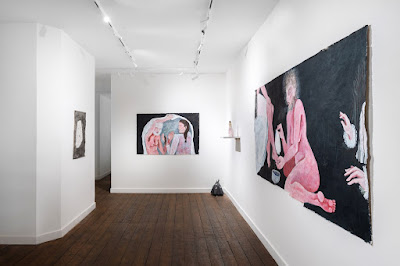Tamsin Snow at Block 336
For this solo show at the consistently impressive Block 336 in Brixton, Dublin-based artist Tamsin Snow uses installation and film to provide a fairly complex commentary on the way architecture has the power to not only shape our emotions but physically crystallise political and social ideologies from institutions and other authorities. The space itself is crisp and immaculate; although Block 336 is based in what looks like a former car park or warehouse, the clarity of the video works alongside its vast spaces is quite a breathtaking combination.
Upon entering the first gallery space, 'Waiting Room', an intriguing installation, presents itself. The concept of the waiting room as the first part of an exhibition isn't exactly groundbreaking, in fact I saw it at GAO Gallery in Whitechapel a couple of weeks ago in a show by Godai Sahara; however for Snow this is the point of departure to make the viewer instantly think about the power of interior design, as the plastic seats are positioned at a 90-degree angle from the screen, so it is either impossible to see the video piece or the viewer must sit uncomfortably on the chairs. The film acting as a synthetic window is similarly unnerving as CGI raindrops repeatedly run down the screen in silence. A sterile palette of a range of whites, greys and blacks are recurring, from the gallery walls to the chairs to the video, again providing a blank framework in order to truly draw attention to the art.
Installation view: Tamsin Snow, Waiting Room, 2018. CGI video animation, dimensions variable.
Image courtesy of Block 336.
Upon entering the first gallery space, 'Waiting Room', an intriguing installation, presents itself. The concept of the waiting room as the first part of an exhibition isn't exactly groundbreaking, in fact I saw it at GAO Gallery in Whitechapel a couple of weeks ago in a show by Godai Sahara; however for Snow this is the point of departure to make the viewer instantly think about the power of interior design, as the plastic seats are positioned at a 90-degree angle from the screen, so it is either impossible to see the video piece or the viewer must sit uncomfortably on the chairs. The film acting as a synthetic window is similarly unnerving as CGI raindrops repeatedly run down the screen in silence. A sterile palette of a range of whites, greys and blacks are recurring, from the gallery walls to the chairs to the video, again providing a blank framework in order to truly draw attention to the art.
Installation view: Tamsin Snow, Waiting Room, 2018. Plastic seats, car spray paint, faux leather, CGI video animation, dimensions variable. Image courtesy of Block 336.
Sitting on the seats gives the viewer nothing but a blank wall to gaze upon, and this bizarre blankness continues somewhat into the second gallery space, where visitors must use shoe protectors to walk or sit on the incredibly soft white carpet that lies in front of the huge screen showing the exhibition's eponymous film. Exactly how cosy and comfortable this rug is to sit on is hard to explain, and contributes to the multi-sensory element of the installation; it is white and sterile but soft and warming, much like the two competing ideals of modernist architecture and interiors.
Installation view: Tamsin Snow, Spare Face, 2018. CGI animation, 8:00 minutes.
Image courtesy of Block 336.
The eight-minute-long film takes the hybrid form of a residential commercial and a CGI walk-through of a speculative building, with crisp white furnishings and interior decor; the spaces are barely used and have been formulated efficiently. It is clear that a great deal of research has been done by Snow on futuristic, post-human medical research, and how architecture might accommodate and emulate these purposes. With a screen as large as that in Block 336, the film almost plays the part of a virtual reality headset, visually guiding the viewer forcibly through these unknown spaces, with a text script rolling across the screen. Phrases such as claiming to "generate synthetic skin substitutes" in order to create "desired morphologies and lifestyles" pointedly address questions and concerns of the contemporary moment as well as how the spaces we (re)claim and are drawn to can shape our thoughts and actions through space. Of course, the colour white is no accident either, with the ongoing sterile hues evoking the antithesis of comfort and warmth. Erring the viewer is a very contemporary phenomenon in art, especially through installation, and is executed perfectly here, without being alienating. We can all recognise Snow's dystopian landscapes, in fact it leaves us thinking about how our behaviours might be shaped by them.





